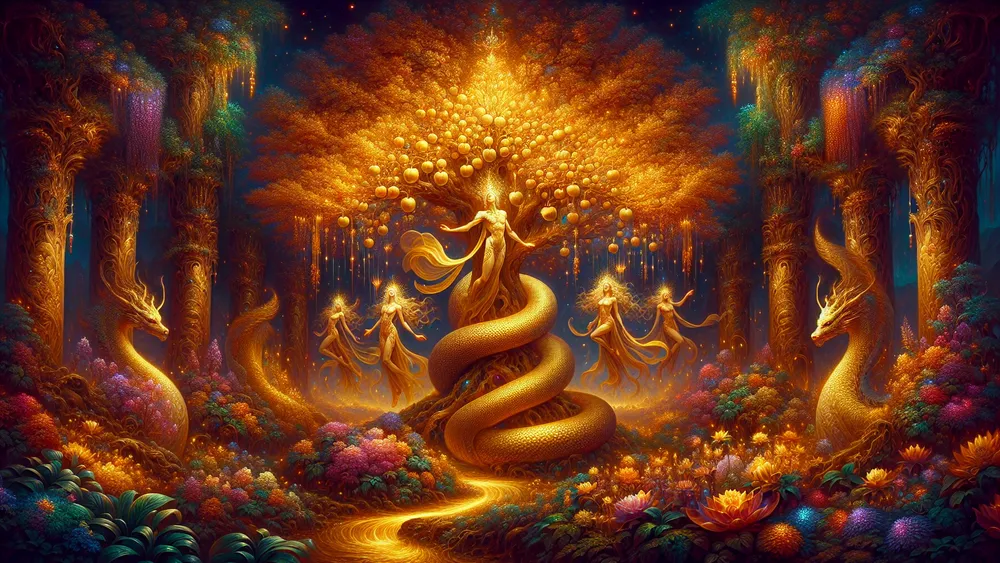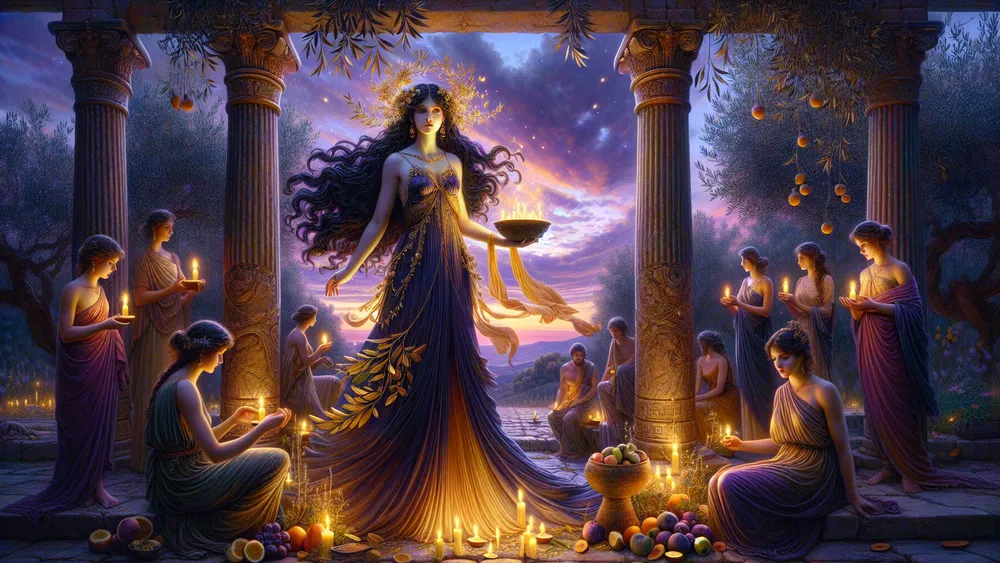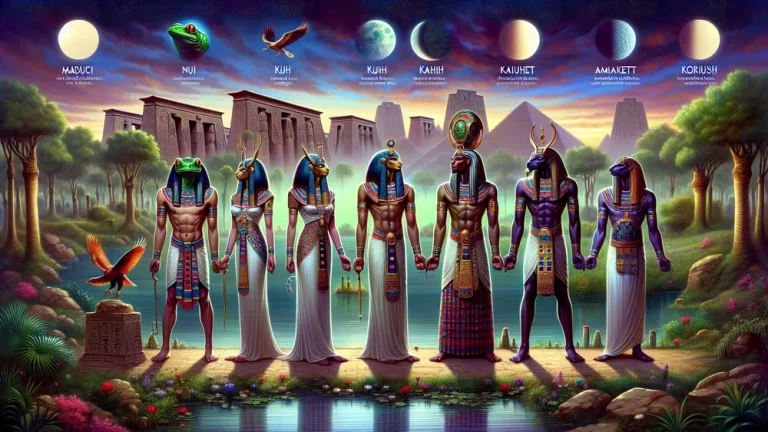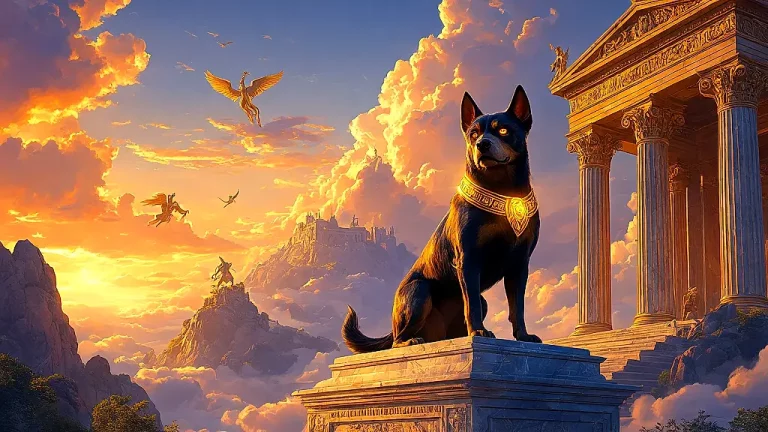Hesperis In Greek Mythology: Daughter Of Evening And Beyond
In Greek myths, Hesperis is a somewhat unclear and interesting character. Called the “Daughter of Evening,” she means the time of twilight, when daytime starts turning into night. Larger figures like Eos (morning) or Hemera (daytime) are more often talked about. But Hesperis has a role that fits into something different – she stands for balance and in-between moments.
Key Points:
- Hesperis is the Daughter of Evening, symbolizing dusk, the time between day and night.
- She is often described as the child of Nyx (Night) and Erebus (Darkness), with siblings like Hemera (Day), Hypnos (Sleep), and Thanatos (Death).
- She connects light and dark, linking her sister Hemera (Day) with her mother Nyx (Night).
- Hesperis is tied to the Hesperides, guardians of the Garden of the Hesperides, which holds the golden apples of immortality.
- Unlike major gods, she has no big myths and represents balance and quiet transitions instead.
- Artistic portrayals of her are missing, mirroring her small role in myths, but dusk rituals may reflect her symbolic role.
- Hesperis’ importance lies in linking opposing forces, showing how ancient Greeks valued cycles and balance in nature.
Her part in myths feels like the dim colors of the sky when the sun sets: hard to notice, not very bright, but definitely part of how the Greeks understood how the world worked. The stories about Hesperis don’t agree very well. Some sources mean one thing about where she came from, while others mean something else completely.
These differences make her harder to place, but when you think about her lineage, her connection to others in myths, or even her connection to the well-known Hesperides, the mystery starts to make a little more sense. The role she plays turns clearer, showing her importance as someone in the middle of light and dark. Her story ties the opposite ideas of brightness and shadow together.
If you pay attention to her story here, it might help you understand both how the Greeks thought about myths and how they connected things like art or rituals to big abstract ideas.
Hesperis: Overview and Key Facts
| Aspect | Details |
|---|---|
| Name | Hesperis (Ἑσπερίς), which means “Evening” in Ancient Greek. |
| Area | Focuses on the time of twilight, the point where day starts to become night. |
| Parentage | Often considered the daughter of Nyx (Night) and Erebus (Darkness) in works like Hesiod’s Theogony. |
| Siblings | Hemera (Day), Hypnos (Sleep), Thanatos (Death), Nemeses (Retribution), and many others born to Nyx. |
| Representation | Stands for times of change, steadiness, and the in-between, as well as the balance of life and the universe. |
| Ties to Nature | Connected to the star in the evening sky, called Venus, and the dimming light seen as day ends. |
| Role in Myths | Not a very well-known ancient figure. She represents dusk’s mysterious balance but wasn’t in many major myths. |
| Related Figures | Sometimes tied to the Hesperides, who are nymphs that watch over the Garden of the Hesperides and reflect themes of evening and protection. |
| Depictions in Art | She was not shown much in older Greek artwork, and this matches her small, unclear role compared to bigger gods. |
| Meaning in Culture | A figure tied to the beauty and mystery of twilight, which was important in both myths and rituals. |
Where Hesperis Comes From and Her Family Tree
To get a better idea of Hesperis and what her role means in myths, it’s important to first look at where she comes from and her family ties. To see where she belongs in the myths, we need to focus on the system of gods in Greek stories. This is where her connections to her parents and siblings start to matter.
Who Are Her Parents and Siblings? Daughters and Sons of Nyx
Hesperis is part of the important family line of Nyx (Night) and Erebus (Darkness), two very old gods who stand for basic forces in the world. In one old story, Theogony by Hesiod, it is written that Nyx and Erebus were two of the first beings to come from Chaos. Together, these two gods had many children who each stand for either an idea or a part of the natural world.
Nyx and Erebus are thought to represent two sides of the same thing: night and shadow. People think this fits well because their daughter, Hesperis, means evening time. Hesperis has many siblings, and they are big figures in myths who are all connected to interesting ideas. There is Hemera (Day), who is the opposite to her mother, Nyx. Hemera stands for daylight.
Then there is Hypnos (Sleep) and his twin brother, Thanatos (Death). One represents sleep and rest, while the other means the end of life. Another is Nemeses (Retribution), a goddess who is in charge of balance and justice.
Here is a list of Nyx’s children and what they are tied to:

- Hemera: She stands for the daytime and is the bright opposite of her mother.
- Hypnos: The god tied to sleep and dreams.
- Thanatos: A god connected to death and the end of life for everyone.
- Nemeses: A goddess who is linked to fairness, balance, and punishment.
- Eris: She means chaos and conflict in both human and godly places.
- Momus: A god tied to criticism, making fun of others, and foolishness.
This long list of siblings helps us understand how wide the role of Nyx’s family is in myths. Hesperis, though, has a special place. She represents the evening and connects the light of her sister, Hemera, and the darkness of her parent, Nyx.
Hesperis, the evening goddess, bridges the brightness of her sister Hemera (Day) and the darkness of her mother Nyx (Night), as part of a family representing key aspects of the world like sleep, death, justice, and chaos.
How Hesperis Bridges Day and Night
Hesperis has a significant job in Greek myths. She represents twilight, which is the short time when the day becomes the night. Greeks saw this moment as important because it connects two opposite things – daylight and darkness – and it happens naturally without any interruption. Even though there are no big stories or actions linked to Hesperis, she can still be understood as a symbol.
She means the smooth and quiet change between the bright skies of Hemera (Day) and the dark, quiet world of Nyx (Night). In a way, Hesperis explains how the world stays balanced, even when opposites meet. Twilight was not just dimming light to the Greeks; it was a time that gave them the chance to prepare for what was coming.
It was a moment to think about the end of one thing and the start of something else. For instance, dusk, which happens under Hesperis’ presence, was a crossing point between two major parts of the day, and it gave people time to reflect as night approached.
States like these mattered to the Greeks – they saw dawn, dusk, and even the line between life and death as balanced times. Hesperis, who connects closely to her sister Hemera and her mother Nyx, had a job to keep things calm and steady at twilight.
Dawn might mean the start of a new day, but dusk – watched over by Hesperis – meant closing things out while moving into rest and renewal. For this reason, even though gods like Eos (dawn) or Selene (moon) are more well-known, Hesperis is still important. Her role also explains how day and night do not feel abrupt.
Instead, they flow into each other, and this quiet change was something the Greeks cared about because it reminded them of the rhythm of nature.
Stories About Hesperis in Mythology
Hesperis does not often appear as a main character in myths. Still, what she means in Greek stories about the universe gives us interesting ideas to think about. While there are no long stories written about her, fragments of her tale and her links to other bigger themes in mythology are worth looking at.
We can think about her broken-up stories and how they tie into larger ideas in myths. Even though Hesperis might seem like a smaller figure, what she stands for – twilight – appears in some important ways in the world of Greek myths.
The Missing Pieces: Stories Where Hesperis Shows Up (Sort of)
Hesperis is a figure in Greek myths that we don’t know much about. She does not have stories that make her a main character. Unlike her siblings – Hemera (Day), Nyx (Night), or the Hesperides nymphs who share part of her name – Hesperis seems to exist more as an idea than someone with a role in stories.
This could be because her domain, twilight, is not really a fixed time or an actual thing. Twilight is short and is just the in-between time when day becomes night. In Greek myths, some parts of nature or ideas were represented as people, but not all of those ideas were important enough to become main figures in stories. Hesperis seems to be one of these.
Twilight means something important in the universe, but it did not need a story to explain it. This might also be why no myths wrote about her directly. Her part in the world was more about balance and the way things work together.
The Greeks seemed to care more about figures that showed action or created big changes – like gods who fought battles or changed the world. Twilight, though, is quiet. This makes Hesperis feel like other quiet figures, like Aether, who stands for light but doesn’t show up much in myths. But for people in ancient Greece, twilight was important. It was a time to stop and think, to prepare for night.
At times like that, what Hesperis meant probably mattered in rituals or ideas about the universe, even if there were no real stories about her. Twilight connects opposites – bright days and dark nights – just like Hesperis links two states without causing a break. Even though she isn’t celebrated like Zeus or Athena, her part helps explain how the Greeks appreciated cycles in nature.
How Hesperis Connects to Nyx: The Goddess of Night
Hesperis is connected to Nyx, one of the oldest and most powerful gods in Greek mythology. Nyx, who represents Night, comes from the first group of gods and is described in Hesiod’s Theogony. She was seen as mysterious and powerful, even more ancient than Zeus or the other Olympian gods. Nyx is said to be covered in darkness, and she had many children.

Each one of these children represented an idea in nature or life itself. Some of them were Hypnos (Sleep), Thanatos (Death), Moros (Doom), and the Keres (Spirits of Violent Death). In this large family, Hesperis is one of the smaller, quieter forces. Her connection to twilight ties her to Nyx’s control over the night’s mysteries.
Twilight, which Hesperis represents, feels like it is part of Nyx’s influence. It’s a moment when the night steps back and gives time for dusk, but the night doesn’t totally leave yet. Nyx, who symbolizes both chaos and order, means something much bigger than Hesperis, yet her role as twilight reflects a smaller version of these larger ideas.
The Greeks thought of Nyx as something awe-inspiring because she connected creation and destruction. Twilight, on the other hand, is more like an in-between place. Like Nyx bridges the space between Chaos and the gods’ order, Hesperis links day and night. This makes her like a smaller example of how her mother’s power works.
Even though there are no well-known stories about Hesperis, the way she fits into the cycle of light and dark makes her important. Hesperis’ job as twilight gives us an idea of quiet balance, keeping both light and dark connected in a way the Greeks found meaningful.
The Garden of the Hesperides: What It Means and Why It Matters
The Garden of the Hesperides is one of the most famous places in Greek mythology. It is linked to ideas about keeping things safe, creating barriers, and maintaining balance. These themes are similar to what Hesperis stands for. The garden is best known for holding the golden apples of immortality, which were a gift from Gaia (Earth) to Hera when she married Zeus.
In the garden, the Hesperides, sometimes called the Daughters of Evening, worked as guardians. Along with them was Ladon, a huge and dangerous serpent who also kept the apples safe. The garden is a place where the world of gods and people came close together, but it made sure these two realms stayed apart. This is clear in one of its most famous myths – Heracles’ eleventh labor.
He was told to steal the apples as part of his challenges. This wasn’t just about strength; it tested his cleverness and his ability to overcome limits.
The name Hesperides comes from Hesperis, and because of that, it connects her to the idea of transitions, like the twilight time she represents. Thinking about this garden and its role in myths can help explain some important themes:
- Guardians and Protection: The Hesperides and Ladon defended the sacred apples to keep divine order, making sure sacred places stayed safe.
- Heracles‘ Test: The eleventh labor made the garden a part of the story of one of Greek mythology’s greatest heroes, showing it as a trial of determination.
- Symbolizing Barriers: The garden stood for a clear division, like a wall, between mortal and divine worlds, just like the time of dusk (Hesperis’ area) creates a break between day and night.
This garden wasn’t just a place in stories. It meant balance, safety, and the passing between two worlds, which matches perfectly with what Hesperis represents.

The Garden of the Hesperides symbolizes protection, balance, and the division between mortal and divine, with its guardians and trials like Heracles’ labor emphasizing its role in maintaining sacred order.
How Hesperis Was Seen in Art and History
While Hesperis is hard to notice in myths, it is worth thinking about whether her role was included in ancient art or in objects from that time. In myths, her importance might be unclear, but the things people made could help us understand how she mattered – if she was depicted at all.
We can look into whether her role was ever represented in paintings, sculptures, or other objects made by the Greeks. This raises the question: Could her less obvious role in mythology have been part of the art people created to explain their world?
Artistic Portrayals of Hesperis in Ancient Greece
Hesperis is hard to find in artwork or objects from ancient Greece. No clear images or sculptures of her have been uncovered. This might be because she represents twilight, which is a quiet and in-between idea. Twilight, unlike clear actions or big events, is harder to picture in visual art.
Other figures such as Hemera (Day) and Eos (Dawn) sometimes appear in vase paintings or carvings, but Hesperis seems to have been left out. Her connection to dusk probably made her less noticeable and less dramatic, which may have made artists prefer other subjects. The Hesperides, who are tied to the evening and the golden apples, do appear in some Greek artwork.

However, there is no real proof that their images are directly linked to Hesperis as a person. Greek artists tended to focus on gods, heroes, and myth stories with strong action or obvious emotion. Because of this, quieter figures like Hesperis did not get much attention in art.
Here are some points about Hesperis and other similar figures in art:
- Abstract Figures in Art: Like Hesperis, other ideas such as Moros (Doom) or Nemeses (Retribution) rarely appeared in Greek art because their roles were less physical or visible.
- Preference for Heroes: Artists from Greece preferred to make things about bold myths, like the labors of Heracles, rather than ideas like evening or transition.
- Ties to the Hesperides: Art showing the Hesperides or their garden does not directly link them to Hesperis, which keeps this connection unclear.
Altogether, Hesperis’ role may have mattered symbolically, but it didn’t carry over into most ancient Greek art.
Hesperis in Ancient Ideas and Rituals
Though Hesperis is nearly impossible to find in pictures or objects from the past, her importance might still be seen in rituals and practices from ancient Greece. These rituals were often connected to the time of twilight, which is a moment of change between day and night. Her role, which is not very clear, might have mattered in how people thought about these shifts.
Twilight is a short, quiet phase, and this may have made her role more about meaning than action. Instead of focusing on drama, people may have linked her to ideas surrounding change. The ways Hesperis mattered in culture show that, even without physical depictions, her symbolic role probably had meaning.
Daughter of Evening: Rituals and Symbols Linked to Dusk in Greece
In ancient Greece, the change from day to night was marked by rituals and symbols that connected with the role of Hesperis, often called the “Daughter of Evening.” Since dusk was an in-between time, it was seen as especially important. People believed it was a time when safety and balance were needed, so they carried out prayers and other acts to prepare for nightfall.
Deities like Hesperis and Nyx (Night) were thought to protect against harm as darkness grew. During this time, people lit lamps or offered food and drinks. These things kept light and hope present as night arrived. The Greeks often saw twilight as a moment to protect their homes and prepare for the unknown.

It connected to how Hesperis’ role stood between lifeless transition and order.
Here are examples of these ideas in practice:
- Prayers and Offerings: People asked gods at twilight for protection and an easy shift into nighttime.
- Lamps for Light: Lighting lamps kept the light present during early nighttime.
- Focus on Boundaries: Dusk rituals were often performed near doorways and thresholds, linking to ideas of change and balance.
In these acts, Hesperis’ role as a part of twilight can still be understood. The Greeks valued this time as one of reflection and planning.
Comparing Hesperis with Other Gods of Light and Darkness
In Greek mythology, Hesperis has a special role. She is the goddess of dusk, placed in the middle of day and night. This position makes comparisons with other figures of light and darkness easy to see. Hemera (Day), who is her sister, brought daylight across the sky. She represented clarity, visibility, and energy.
Her mother, Nyx (Night), stood for the unknown and mystery. People often thought of Nyx as more powerful and even dangerous because she was linked to the universe and death. Hesperis worked between them, softening their differences, just like the colors of twilight ease the shift from day to night. Meanwhile, Aether (Light) ruled the steady, bright air in the sky, representing something that never changed.
But Hesperis symbolized the light at sunset, which is very brief yet important. There are other comparisons. Hypnos (Sleep) is like Hesperis because he exists in-between states. While he governs the line between being awake (day) and dead (a kind of night), Hesperis exists in the passing from day to night. But Hypnos focuses on internal states, and Hesperis impacts the outer world. Another similar figure is Eos (Dawn).
She signaled the start of the day with energy and action. Compared to her, Hesperis is calmer, focusing on thought and preparation instead of beginnings.
Here is how the deities compare:
| Deity | Domain | Symbolism | Role in Cosmology |
|---|---|---|---|
| Hesperis | Dusk | Change, reflection, and preparation | Balancer between day and night |
| Hemera | Day | Clarity and life | Representative of daytime and visibility |
| Nyx | Night | The unknown and powerful forces | Force over darkness |
| Aether | Pure Light | Steadiness and unchanging clarity | Brightness of the heavens |
| Hypnos | Sleep | The line between awake and unaware | Over inner life transitions |
| Eos | Dawn | Energy and renewal | Sign of the coming day |
This comparison reveals how each deity plays a different part in the cycle of Greek cosmology. Hesperis may not stand out like the others, but her role in balancing the extremes of light and darkness is essential.

The Bigger Picture of Greek Gods and Forces
In Greek mythology, there is a network of gods and forces, each connected to specific parts of the natural world or ideas about life. These gods also help explain how the universe is structured. A good example is Hesperis, who stands for dusk. She helps illustrate how the Greeks gave meaning to moments of change, focusing on things like balance and connections.
In a larger system, Hesperis worked as a link between opposite forces, such as light and darkness, or day and night. All the gods, whether the famous Olympians or the quieter ones like Hesperis, played parts in keeping balance in the universe. They were not separate but instead part of a greater whole.
This system shows that the Greeks thought carefully about how events and forces were tied together. To explore and learn more about these relationships, you can look at a detailed catalog of abstract and natural forces in Greek mythology.
This entire framework means the Greeks had a thoughtful yet practical way of connecting ideas, natural events, and life experiences into one complete worldview. It reveals how their myths combined deep thinking with simple explanations of the world.
FAQs
1. Who were the siblings of Hesperis in Greek mythology?
The siblings of Hesperis in Greek mythology include deities such as Hemera, Hypnos, Thanatos, and Nemeses, all children of Nyx and Erebus.
2. What is Hesperis’ connection to the Garden of the Hesperides?
Hesperis’ connection to the Garden of the Hesperides lies in her association with the evening and her potential role as a namesake for the Hesperides, the nymphs who protect the garden at the edge of the world.
3. Are there myths directly focused on Hesperis?
Myths directly focused on Hesperis are virtually nonexistent, as she primarily appears in Greek mythology as a symbolic figure rather than a main character.
4. How does Hesperis symbolize the concept of dusk in Greek culture?
Hesperis symbolizes the concept of dusk in Greek culture by embodying the transitional moment between day and night, reflecting themes of balance, transformation, and liminality.






